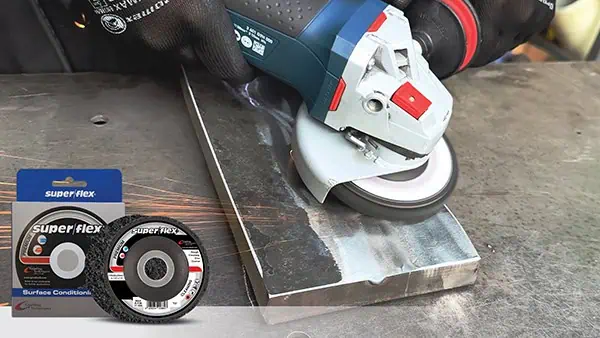NON-WOVEN abrasives are three-dimensional webs of nylon, or synthetic fibres with globules of resin and abrasives embedded into the network of fibres.
Used in various industries, they offer a range of benefits on application due to their unique structure, making them the preferred product of choice for a number of surface preparation and or finishes.
Grinding Techniques’ offerings include an extensive range of non-woven products, including discs, pads, flap wheels and stationary wheels – which are particularly popular within the stainless steel industry due their ability to blend and polish weld seams rapidly and effectively.
Within the yacht building industry, railings are manufactured using high grades of stainless steel, that require an aesthetically appealing finish.
Often, when welded together, unsightly rough seams are created. Removing or blending these are normally achieved by using conventional abrasives with a combination of tungsten carbide burrs, fibre or flap discs. However, achieving the desired end result will require a number of steps as blending, or removal of scratch patterns left by these abrasives will constantly require removal or blending.
Using a metal finishing unitised wheel will drastically reduce these steps, as the weld seam can be removed without any reworking required, allowing the railing to be immediately available for polishing with buffing wheels and polishing compounds. Manufactured from layered non-woven abrasive sheets one on top of the other, then compressed, these wheels are graded by density and hardness, where the denser the wheel, the harder it becomes.
Other non-woven stationary wheels include the convolute or light deburring wheel, which are used within the tank industry.
Manufacturing stainless steel tanks for the petrochemical or food-related markets such as dairy tanks, undergo a number of processes whereby various scuff, scratch and even light gouges can occur.
As these particular tanks are extremely big in diameter, they are mounted on huge roller beds for mechanical rotation as cleaning and processing by hand would take hundreds of hours to finish off.
Depending on the required finish, light deburring or convolute wheels (in various densities and hardnesses) are mounted on machines for surface finishing applications. Providing even pressure along the length of the tank as it moves up and down, any scratches or blemishes on the surface are removed whilst an even consistent finish is provided.
Another industry where great focus is placed on surface finish, is the panel beating market where the finished painted surface is heavily impacted by the correct paint removal and preparation techniques.
Abrasives offer various options for paint removal, like sanding and velcro discs, which again requires a number of additional steps as each step in the application could leave scratch marks on the surface of the panel, which in turn requires a finer sanding for removal.
Grinding Techniques manufactures and supplies a wide range of abrasive products to the global market which includes reinforced cutting and grinding wheels, bonded abrasives, tungsten carbide burrs, coated abrasives, diamond wheels and diamond saws.
